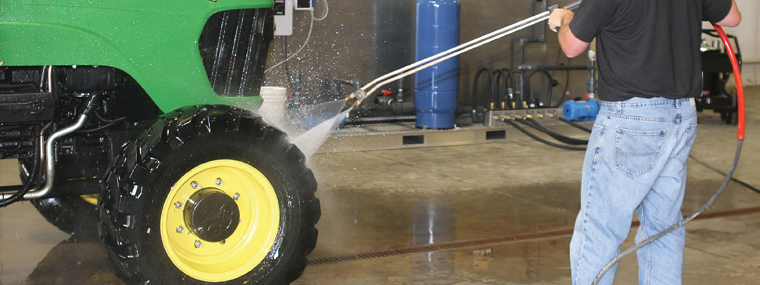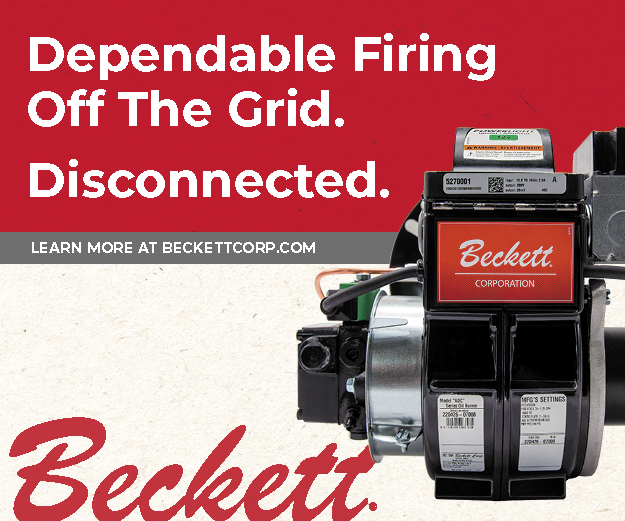
Choosing A Water Treatment System
By Diane M. Calabrese / Published July 2019

Profligate is the word often used to describe those who spend too freely, but each of us can be reckless in our own way now and then.
If there’s any “now or then” that unites us, it is water use. Being so ubiquitous, water’s precious nature can be forgotten—until clean water becomes scarce.
Prudent use of water goes a long way in ensuring freshwater continues to flow freely. The care taken extends to capturing wastewater and treating it so that in most cases it can be reused.
Municipal sewage plants handle large-scale wastewater capture and treatment activities. But in 2019, the responsibility for collection and treatment of wastewater increasingly begins (and sometimes ends) with the end user, especially businesses.
Wastewater collection and treatment of water used by power washing contractors is no longer merely a considerate thing to do. In many parts of the country, it is a requirement.
“When talking to contractors, one of the first questions I typically get is, ‘Do I have to reclaim my wash water?’” says Aaron Auger, water treatment division manager at Mi-T-M Corporation in Peosta, IA. “My answer is typically that regulations vary from town to town and state to state, but incorporating the reclamation of your wash water into your standard practice ensures that you won’t have issues when it comes to illegally discharging wash water.”
Even if it’s not required, setting up a reclamation system can give a boost to a contractor. “It can be used as a selling feature to set your company apart from competitors and bring a higher level of professionalism to your business,” says Auger. The adoption of a water reclamation system also affords protection should some regulated substance (e.g. lead) be dislodged in cleaning and mixed with the wash water. “The term ‘cradle to grave’ not only holds the contractor potentially liable, but also everyone associated with the job,” says Auger.
When choosing a water treatment system, a contractor should first figure out whether a system is required and what the regional regulatory authority’s specifications for that system are; then, consider the options available. There’s no need to go it alone.
“A CETA-certified distributor is always the first person that I refer customers to,” says Auger. “[End users] can find out what their local regulations are by searching, but more often than not, the distributor that covers that area has likely been asked those questions before.”
The second question for a buyer is whether or not to choose a system that exceeds existing requirements. Capturing wastewater and disposing of it properly are the only things required by some jurisdictions. But the contractor may want to consider being ready to filter or treat in some other way. (See next section.)
“Like all products, there are a number of options out there,” says Auger. “But talking to a pressure washer distributor will give you the information you need to make an informed decision and get you the best product for your particular needs.”
What’s the goal?
To make an informed decision when choosing a treatment system, a contractor must identify the type or types of treatment desired. The variety of systems offered by Auger’s company are illustrative of the range of options end users have.
There are mechanical systems capable of removing free hydrocarbons and filtering water (www.mitm.com/industrial/water-treatment-systems)—water that can then be sent back to pressure washers. There are also biological systems (tap bacteria to break down oils), separators that remove oil from wastewater, and more.
Manufacturers that serve the waste-water treatment needs of power washing contractors bring years of experience to their task, such as providing collection and treatment systems to facilities like car washes and manufacturing plants. Cutting-edge solutions to treatment now exist at a scale that suits contractors at jobsites.
For example, portable water filtration systems and portable water recycling systems designed with power washing contractors in mind are available at www.ultimatewasher.com/wash-water-filtration-systems.htm. Mobility and the basics are all part of the offerings of companies, so that recovery tools (containment mats and vacuums) and treatment systems are both on the same product roster (www.alkota.com/products/water-treatment-and-recovery-systems).
Customers can be served best when the distributor and manufacturer are able to respond to specific goals. The more complicated and varied the work being done, the more needs the buyer of a water treatment system will have.
In-plant treatment systems may require an odor-abatement scheme. Riveer, which meets the needs of military and municipal buyers as well as many others, includes continuous automatic ozone and continuous automatic bacteria and air injection (riveer.com/treatment-systems/rts-3000) as two methods of combating odor producers.
The overarching goal of wastewater treatment—the one that unites contractors and the largest municipal treatment plants—is to extract from water the substances that in colloquial terms “pollute” water. Removal of suspended solids (by filtration or agitation and sedimentation) puts the process on a good course.
Left in water, solid material uses oxygen when it decays. Oxygen-dependent animals living in water are then deprived of oxygen. The cycle launched is not a good one.
Preventing pollutants—not just solids that decay, but also nutrients used to fertilize (e.g., nitrogen, phosphorous), chlorine and related compounds, metals (e.g., mercury, lead, cadmium, chromium and arsenic), and pharmaceuticals from entering the surface waters of the United States (the essence of the Clean Water Act) is an enormous task. In many ways, industrial users of water are far ahead of residential users (think pharmaceuticals and personal care products going down home drains), but everyone needs to do more.
There’s little possibility that contractors across the nation will not eventually have the same responsibilities for treating water that manufacturing, food processing, and other large facilities do. As environmental consultant Robert M. Hinderliter tells us in the “Legislative Updates” article in this issue on page 42, a contractor need only look at the NPDES permit pending in the jurisdiction in which he or she is working to know what will be coming next.
Scaling Down, Meeting Requirements
Analogous but not identical. That’s the best way to view the processes within a wastewater treatment plant and a water treatment system used in a portable unit by a contractor or a larger unit by a manufacturing, food processing, or other plant.
Screening (filtration), pumping (or exploiting gravity), aerating, removing sediment, and eliminating bacteria are among the major processes as a wastewater treatment facility. Residuals are collected and treated in ‘digester’ tanks where bacteria that thrive on the residues digest them, thus eliminating disease-causing organisms and odors. (For a good primer on treatment, see www.usgs.gov/special-topic/water-science-school/science/a-visit-a-wastewater-treatment-plant?qt-science_center_objects=0#qt-science_center_objects.)
Water exiting a treatment plant (reclaimed water) is clean enough to enter the surface and ground waters of the United States or be treated further to become drinking (potable) water. In California, pipe systems dedicated to reclaimed water convey it to places where it is used directly for non-potable purposes.
Location is everything at this juncture in terms of what type of water collection and treatment system is required by end users of pressure washers and related equipment. In the Buckeye State, the Ohio EPA’s Division of Surface Water (DSW) is responsible for issuing permits for wastewater discharge.
The Ohio DSW makes the strongest recommendation that in addition to meeting requirements for handling wastewater, water users invest in recycling equipment that enables on-site reuse of water. So it’s forward-looking to think not only of collection and treatment, but also recycling when choosing a water treatment system.
The Ohio DSW also reminds contractors that may be working at a company that has a NPDES permit for discharge into a storm sewer that the permit does not mean the contractor can simply use the storm sewer, too. Similarly, in Ohio, a mobile component of a power washing business carrying water from a job site to dispose of it at a stationary component of the business, such as the company’s car-wash facility, may be a violation of regulations.
In short, get the NPDES permit(s) required. Read it (them). And factor all into choice of a water treatment system.
In the City of Houston, contract cleaners must have a permit to transport wastewater they collect. The water is considered a regulated waste.
The 2019 rules for pressure washer users in Houston, TX, are stringent. Waste generated from a pressure washer must be reclaimed. Equipment used for reclamation and transport must be available for inspection. A decal is placed on a vehicle/equipment that passes inspection to make it easier for inspectors to identify violators of the system. The combined application and vehicle fee for a single vehicle for one year currently stands at $904.79. (Temporary, shorter interval permits are available.)
Expect more NPDES permitting entities to move in the direction of Ohio and Houston. It’s a distinct contrast to the water quality trading (WQT) option that allows NPDES entities to essentially shift compliance responsibilities among themselves so that in the aggregate, two entities might meet goals collectively where one might otherwise fail.
The longer view approach requires each of us to participate fully in reclaiming, recycling, and reusing wastewater. Choosing a treatment system is a good start.





